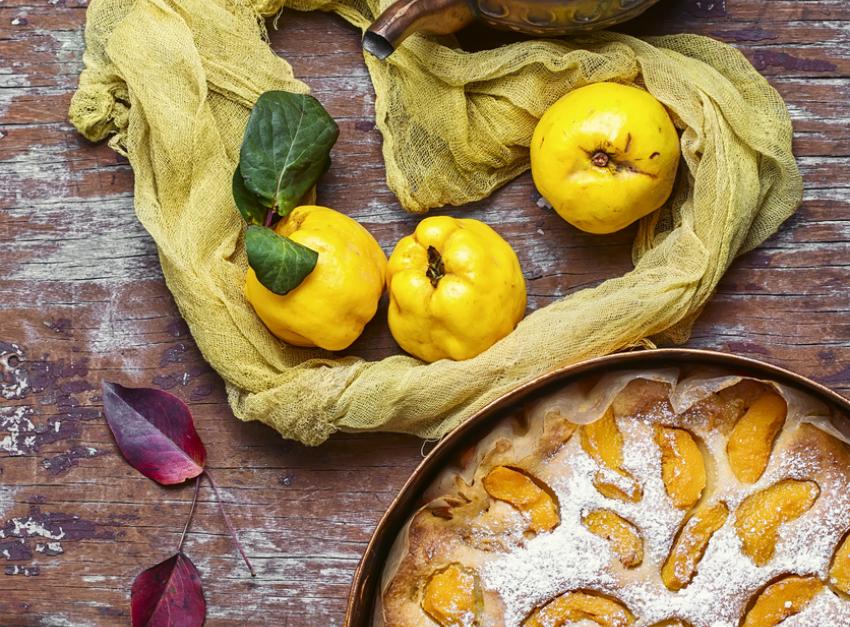
- Ali
I spotted some lovely organic quince at the farm shop and just couldn’t resist them. I knew I had a gluten and dairy free pudding to make for a charity dinner party I was attending and the quince became the centre piece for me. I love the smell of quince as they ripen on the kitchen windowsill. You don’t see them too often so if you do, snap them up, this really is worth making.
The ginger here adds a subtle warmth that accentuates the quince.
If you don’t want to cook the quine in alcohol just omit it and use water instead. All the alcohol cooks off, but you can also leave it out.
Let the cake cool before turning it out. This allows the cake time to gain structure, keeping it fluffy when tipped upside down!
Makes one 8”/20cm round cake, serving 6 - 8
Ingredients
For the quince: Prepare the night before the cake
1 vanilla bean (use seeds below)
1 small (or 1/2 a large) lemon
950 ml water, plus more as needed
250 ml dry white wine
100 g organic coconut sugar
800 g quince (4 large or 8 small)
For the cake:
50ml rapeseed oil
50ml oat milk
100 g coconut sugar
vanilla bean seeds (from above)
3 eggs, at room temperature
2 tablespoons/ 15g finely grated fresh ginger
30g crystallised stem ginger
80 g potato flour
60 g gluten-free oat flour
70 g brown rice flower
2 teaspoons baking powder
1/2 teaspoon salt
100ml Oatly crème fraiche (or other dairy free brand)
Directions
Poach the quince: Do this the night before
Split the vanilla bean down the centre and use the back of a knife to scrape away the seeds. Set the seeds aside to use in the cake, and place the pod in a large saucepan. Use a vegetable peeler to pare 5 strips of lemon peel and add them to the saucepan. Juice the lemon and add the juice to the saucepan along with the water, wine, and coconut sugar. Bring the liquid to a boil while you prepare the quince.
Use a vegetable peeler to pare away the skin of a quince and discard. Cut each quince in half, leaving the seeds in, and add them to the saucepan. Continue with the remaining quince. Place a small, heat-proof plate over the quince to keep them submerged, cover partially with the lid of the saucepan, and simmer. Cook until the quince are rosy and tender, about 1 1/2 hours, adding more water as needed to keep the quince submerged. When cooked remove from heat and let the quince cool in their juices. Once cool (the next day) core the quinces (this is really important as unlike apples they have a really thick core) and cut them into 1/4″ slices.
Return the poaching liquid to the saucepan and simmer until reduced by about half and bubbling thickly, about 10-20 minutes. Reserve.
Make the cake:
Position a rack in the centre of the oven and preheat to 350º.
Line a 8”/20cm baking tin with parchment paper allowing at least 1″ to stand above the pan. Grease the bottom and sides with oil to prevent the quince from sticking. This is really important or it might be a struggle getting the quince from the tin.
Lay the quince slices, slightly overlapping, in concentric circles over the greased parchment and set aside. You may have quince left over. If this is the case, chop them coarsely and set them aside to add to the batter.
Make the cake batter:
In the bowl of a food mixer (or in a large bowl), combine the oil, vanilla bean seeds, and sugar. Beat on medium speed until light and fluffy, 3 minutes. Add the eggs one at a time, beating until combined after each and scraping down the sides and bottom of the bowl as needed, then beat in oat milk and the grated ginger.
Meanwhile, sift the fours with the baking powder and salt into a medium bowl.
With the mixer on low, stir half of the flour mixture into the butter mixture until just combined. Stir in the Oatly crème fraîche until just combined, then the rest of the flour, scraping down the sides and bottom of the bowl as needed. Stir in the chopped quince, if using, and give the batter a final stir by hand to make sure it is well-combined.
Spread the batter evenly over the quinces.
Bake the cake at 180 degrees until the top is golden and a cake tester inserted near the centre comes out clean, 40-50 minutes. Let the cake cool completely, then invert onto a serving platter and peel away the parchment.
If the reduced poaching liquid has solidified, warm it in a small saucepan until liquid. Brush this glaze over the top of the cake. Serve the cake at room temperature.
Extras will keep in the refrigerator for a few days.







